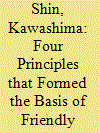| Srl | Item |
| 1 |
ID:
192558


|
|
|
|
|
| Summary/Abstract |
What is the structure of the political framework that defines the relationship between Japan and China? In the early 2000s, a little before the thirtieth-year anniversary of normalization of the bilateral relationship, experts from the two countries argued over the importance of issues regarding history in the framework of bilateral relations. By discussing the formation of the debate on the so-called “1972 system,” and its background and subsequent development, this article indicates that China’s argument is transforming from rational to more nationalistic. The two consistent features of China’s strategic theory toward Japan are (1) China shares with Japan an understanding of where the issues in Sino-Japanese relations lie; and (2) China differs in many respects from Japan in its political interpretation of the issues and seeks setbacks from Japan in a manner consistent with guiding domestic public opinion in China. This implies that Japan and China can potentially share a common understanding of the issues at stake, despite political friction on the surface.
|
|
|
|
|
|
|
|
|
|
|
|
|
|
|
|
| 2 |
ID:
172524


|
|
|
|
|
| Summary/Abstract |
This article examines Nakasone Yasuhiro’s policy toward China as a politician, including his remarks in the Diet before appointment as prime minister as well as exchanges with Chinese leaders during his prime ministership. Nakasone raised Japan-China relations to a level called a “honeymoon” in the 1980s, at which time the four principles of Japan-China relations were shared and there was the prospect of continued friendly relations into the 21st century. Behind the emergence of this era was not only Japan’s support for China’s economic development through ODA, but also the closeness of the stances that both Japan and China held toward the Cambodia and Korean Peninsula issues at the end of the Cold War. This may have been because there was the possibility for both parties to share information and mutually support each other. Nakasone actively talked not only with Hu Yaobang but also leaders such as Deng Xiaoping and Zhao Ziyang. However, as Nakasone’s partner Hu Yaobang was dismissed and the Cold War approached its end, the “honeymoon” between Japan and China came to an end, and the four principles by Nakasone and Hu gradually became just one frame of history.
|
|
|
|
|
|
|
|
|
|
|
|
|
|
|
|
| 3 |
ID:
190139


|
|
|
|
|
| Summary/Abstract |
This article reviews Japan-China private trade from the 1950s to the normalization of diplomatic relations between Japan and China in 1972. Under the Cold War in East Asia, private actors were responsible for trade and business exchanges on behalf of the government in Japan-China relations. Both Japan and China promoted private trade with different political agendas. Japan’s objective was to expand Japan-China exchanges with the concept of separation of politics and economics, while China used private trade as a strategic tool to attract Japanese public opinion toward China. This article will clarify how the intentions of the two countries affected private trade, and how private trade expanded as various trade groups competed with each other.
|
|
|
|
|
|
|
|
|
|
|
|
|
|
|
|